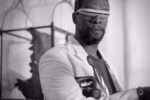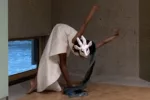While I hadn’t known much about Marina Abramović or her life as a performance artist, I was excited when a friend handed me a copy over New Year’s. I was just able to recently read the Serbian artist’s memoir and found it thrilling, funny, sad, frightening and worth the trip. Not many artists can tell their own stories without falling for themselves completely. The book is her story for art observers and cultural explorers and people who might have waited on line for hours at her MoMA exhibition but never quite found out what the fuss was all about.
Early provocative performances using the body as “bait”

In 1974 a young Serbian artist named Marina Abramović offered herself up as a kind of body bait to a group of strangers in the Studio Mora, in Naples, Italy, with the following, simple instructions:
There are 72 objects on the table that one can use on me as desired.
Performance.
I am the object.
During this period I take full responsibility.
Duration: 6 hours (8 pm – 2 am).
Invited to do whatever they liked to her, some in the audience spun her around, others handed her a rose, a few literally put thorns in her sides; after a few hours the crowd grew more adventurous with some cutting her clothes off with razors, then cutting her skin; some sexually touched her, and one put a loaded pistol in her hand and tried to get her to pull the trigger. After six hours of anarchy, Abramović began to move and the audience scattered, apparently terrified they had awakened her.
That early performance served as the artist’s signature exploration into group psychology, an experiment to see what happens when anything is permitted. What Abramović witnessed (and provoked) was the collapse of societal parameters, and it is essentially the beating heart in her autobiography Walk Through Walls (2016, Crown Publishing).
In 2017, Marina Abramović after decades in the public eye, cutting, tearing, burning and sometimes freezing her skin, standing for hours, sitting for days, walking for months and, occasionally vibrating, has become the grandmother of performance art as her memoir attests – warts, emotional walls and all.
Moving art away from the canvas and pedestal by performing
Performance art is a unintentionally wide open field often incorporating politics, feminism, conceptualism into theater-like, durational experiences. It typically lacks the commodity objects that painting or sculpture produce, but includes a surfeit of documents – photographs, texts, an assortment of props.
Since the early 20th century, artists have longed to leave the confines of the painted rectangle and launch themselves into a more spiritual non-objective realm; the Dadaists of the 1920s turned this tendency into raucous, irrational theater. Indeed, individual artists toyed with all manner of perception of the human condition within the realm of non-object art but almost always employed the human body as theatrical canvas. Marcel Duchamp’s Rrose Selavy performance (1921) is perhaps key: The artist becomes a fictional woman – “eros c’est la vie/eros that’s life” – in a suite of photos by Man Ray.
Years later Yves Klein’s “action” The Leap into the Void/Le saut dans le vide (1960), and early 1960s artists such as Carolee Schneemann, Yoko Ono, Joseph Beuys, Rudolf Schwarzkogler, Chris Burden and Vito Acconci, among others stripped down in one form or another to explain the full range of human consciousness. Schwarzkoggler purportedly cut off his genitals in a performance (Cut, 1965), although it was carefully staged; while Chris Burden had himself impaled and crucified to a Volkswagen and driven around Venice, California (Transfixed, 1974), but not before he had himself shot in the arm with a high-powered rifle (Shoot, 1971).
The artist’s early years
Abramović was by her own account an unhappy and unloved child. Born into communist Yugoslavia, her view of the world was largely shaped by the post-war totalitarian Tito, and her partisan, revolutionary parents. That world was Communist-flavored grey, and the artist’s parents were typically conservative. Walk Through Walls narrates Abramović’s flee to freedom as a predilection of the walls that would soon tumble down in Europe, but her flight was a complex cocktail of politics and a self-described need for love and to confront her fears about not being loved.
Walk Through Walls dials back to the artist’s first efforts to break through her own fears and abilities to endure pain. Abramović performs with a live python, cuts a five-pointed star into her flesh and ignites a circle of fire around herself (nearly setting herself ablaze). Her story evolves dramatically when she meets up with and collaborates with her lover/husband, the West German artist Ulay, and they begin to perform together in works that broaden Abramović’s oeuvre towards themes of trust and love as well as time and space and plain old endurance.
One of their most powerful performances, Rest Energy (1980) took place at Filmstudio, in Amsterdam. Abramović holds a bow and Ulay an arrow that is poised and pointed directly at his her heart. The two lean and angle away from each other as microphones, placed near each of their hearts, broadcast the intensity of their pounding heartbeats into the gallery space. The piece lasted 4 minutes, 10-second. Reading about it is thrilling, exhausting and terrifying. Abramović says: “It was a performance about complete and total trust.”
Ulay and afterwards
A good part of Abramović’s narrative recalls her life with Ulay, motoring around Europe in a van, living a nomadic and romantic life in between performances. These are perhaps the more fascinating (and funny) chapters of her life because we witness the creative and chaotic cauldron in which a great deal of their work was conceived. That relationship, however, concluded in one of the pair’s most ambitious pieces, The Lovers, (1988), a 90-day, 2500 kilometer walk towards each other along the Great Wall of China; meeting in the middle, the two ended their relationship.
Abramović however went on in great ways and her book details further adventures as heartbreak and work combine to forge a new Marina, with a dash of savvy real estate acquisitions and the backdrop of the devastating and violent break up of her native Yugoslavia.

In 1997, Abramović was invited to perform a piece at the Venice Biennale, but both Serbia and Montenegro rejected her proposal. However she was able to secure the basement space in the Italian International Pavillon for Balkan Baroque. Over the course of four days Abramović sat on a massive pile of bloody cow bones, washing and scrubbing them with a metal brush. Accompanied with a film of her mother and father playing in the background, Abramović dutifully scoured hundreds of bones in a room reeking of decay. But thousands flocked to see her mind-numbing work nonetheless, and the piece earned Abramović the Golden Lion as the best artist in the Venice Biennale (1997).
House with an Ocean View at Sean Kelly Gallery

The artist went on to reinvent herself in dozens of durational works. The House with the Ocean View (New York 2002) at the Sean Kelly Gallery featured Abramović living in an open space for 12 days (drinking water, sleeping, standing, sitting, peeing, showering, but not talking).
The Artist is Present
The Artist is Present (2010), her most celebrated work, took place during a museum-wide retrospective of her work. Abramović simply sits in the Museum of Modern Art’s atrium; spectators were invited to sit silently opposite her for as long as she or he liked. Sitting every day, all day, for a total 736 hours and 30 minutes – the entire run of the exhibition – 1,545 people sat with her. Hundreds of thousands witnessed this “silent opera,” waiting in line or watching quietly within the atrium.

While the once unhappy Serbian girl, became a global icon for performance art, fêted by fashion designers, hollywood elites and the likes of Lady Gaga, Abramović was not without detractors. The artist emerged as a kind of shaman and ego-driven Jesus (or Mary) figure, and some art critics found her growing celebrity off putting. The Atlantic said she had “sold out,” others called her a “celebrity darling,” and New York Times art critic Roberta Smith called Abramović’s MoMA 2010 retrospective “cheesy.” The move from downtown to uptown, while a natural evolution in life of a successful artist, made a good many of her stalwart fans nauseous : the thrill of the early days was gone.
Abramović’s trip through the aesthetics of suffering, which the artist turned into an art form, had lost, in a way, its authenticity as she sought out a path forward. Truth be told, the last fifth of Walk Through Walls reads a bit like a resume of her shows and accolades, projects and triumphs and is less than compelling.
If like T.S. Eliot’s Prufrock measures his life in coffee spoons, (The Love Song of J. Alfred Prufrock), Abramović has measured hers in counting steps, or hours or grains of rice, as a calculation of her sacrifice for the other – read ex-husbands, loveless parents, childlessness, aloneness. Somehow the artist stepped out of the purity of her raw cage into a more gilded one. But the artist, while crying, offers no apologies. There is no crime here; the public is fickle, true, but Walk Through Walls, does portend and indicate another kind of performance – persistence.
Walk Through Walls: A Memoir by Marina Abramović, Hardcover, 2016, 384 pages; 16 color pages. Crown Publishing / Division of Penguin Random House $28. Available at Amazon.









